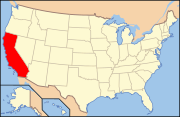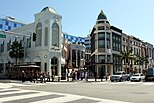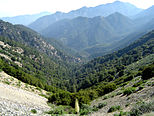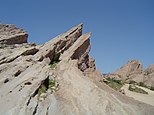Wikipedia:WikiProject U.S. counties/Guideline
| This idea is in the brainstorming stage. Feel free to add new ideas; improve, clarify and classify the ideas already here; and discuss the merits of these ideas on the talk page. |
This is an essay on style. It contains the advice and/or opinions of one or more WikiProjects on how to format and present article content within their area of interest. This information is not a formal Wikipedia policy or guideline, as it has not been thoroughly vetted by the community. |
This is a guideline for the structure of county articles on Wikipedia, as established by consensus of WikiProject U.S. counties. This guideline was constructed specifically for U.S. counties, although could be used on virtually any other county in the world with some minor modifications.
The order of sections is also completely optional, and sections may be moved around to a different order based on the needs of their county. Editors are strongly encouraged, however, to at least begin with the lead and infobox (if any), followed by history, geography, demographics, and economy, since these sections have some good basic information that might be sought after by readers first. Beyond that, editors working on county articles are advised to come to a consensus that works best for the county in question.
While it is just a guideline and there are no requirements to follow it in editing, it contains some of the basic elements of a county article, as well as useful tips that would help to bring the article to good article or featured article status.
County name, State name | |
|---|---|
|
Images, from top down, left to right: Downtown Los Angeles in December 2007, Venice, Los Angeles during sunset, Rodeo Drive in Beverly Hills, Satellite picture of Santa Catalina Island, the Santa Monica Pier, Angeles National Forest, Vasquez Rocks, Antelope Valley California Poppy Reserve | |
| Nickname: "L.A. County" | |
| Motto(s): The county's official motto, if applicable, goes here | |
 Location of the county in California | |
 California's location in the contiguous United States | |
| Coordinates: 34°3′N 118°15′W / 34.050°N 118.250°W | |
| Country | |
| State | |
| Region | Southern California |
| Metro area | Greater Los Angeles |
| Formed | Date that the county was founded (optional) |
| Named for | |
| County seat | Los Angeles |
| Largest city | Los Angeles |
| Incorporated cities | 88 |
| Government | |
| • Type | Council–manager |
| • Body | Board of Supervisors |
| • Board of Supervisors[1] | |
| • Chief executive officer | Sachi A. Hamai |
| Area | |
| • County | 468.9 sq mi (1,214.4 km2) |
| • Land | 303.3 sq mi (785.6 km2) |
| • Water | 165.6 sq mi (428.8 km2) |
| • Urban | 3,352.6 sq mi (8,683.2 km2) |
| • Metro | 6,720 sq mi (17,405 km2) |
| Elevation | 33 ft (10 m) |
| Population | |
| • County | 8,175,133 |
| • Estimate (2014)[4] | 8,491,079 |
| • Density | 17,000/sq mi (6,700/km2) |
| • Urban | 287,759 |
| • Metro | 21,976,224 |
| Time zone | UTC−5 (EST) |
| • Summer (DST) | UTC−4 (EDT) |
| ZIP Code(s) | 100xx–104xx, 11004–05, 111xx–114xx, 116xx |
| Area code | 212, 347, 646, 718, 917, 929 |
| FIPS code | 36-51000 |
| GNIS ID | 975772 |
| Website | officialcountywebsite.org |
The introductory section should introduce the article about the county, serving as a concise overview of the article, establishing context, summarizing the most important points, and explaining why the subject is interesting or notable.
This section should follow the guidelines specified under WP:LEAD. Additionally, a couple of items should be included in the lead section for county articles, including:
- Name of county and location in state
- county proper population (US Census figures should be used. When appropriate, other reliable estimates may be included as a supplement to Census figures.)
- Metro population (US Census figures should be used. When appropriate, other reliable estimates may be included as a supplement to Census figures.)
- Brief note about historical roots/founding
- Nicknames, if notable
- Primary industries supporting its economy (e.g. service, manufacturing, tourism, etc ...)
- Notable unusual characteristics and characteristics commonly associated with it
Aspects of the metropolitan area other than population should be mostly avoided here and relegated to the proper metro area articles.
Names of the county should be given in each of the county's official languages. Pronunciation of the county name should be in IPA as per Help:IPA/English, though can also be in the main local language(s) if thought helpful.
The "red dot" maps for counties (found in the infobox, if any) are being produced by a number of Wikipedians.
History
editThis section provides a narrative of the settlement's history. Topics that can be covered include, but are not limited to:
- the origin of the name; etymology if appropriate
- original inhabitants
- original settlements
- occupying powers/transitions of power
- population spikes
- recessions
- reasons for settlement/growth
- dominant activities
- events that shaped the community
Most libraries will have books on local history. Be wary of loose interpretations, especially when using internet or promotional sources.
Note: History sections can easily become very long with more detail than appropriate for a general overview. While there is no strict rule on how long a section may be, as a general rule of thumb, more than 10 paragraphs or the use of subsection headings might indicate that it should be accompanied by a History of _ main article (using the main template). Only describe the minimum of what is required to understand where the community has come from and let the History of _ article give the details.
Avoid using second-level headings, since they tend to encourage excessive detail and length, and can disrupt cohesion.
Geography
editThis section provides a description of the physical geography. Topics that can be covered include, but are not limited to:
- the settlement's context in the region
- topography, natural features, landscape
- countyscape and skyline
- wildlife and vegetation
- neighborhoods
- infrastructure
The purpose is to describe the settlement as a geographic entity and space. Describe how the settlement exists in the larger region (for example, port on a river, harbor on a sea, agricultural community in the prairies, village in the mountains, suburb of county). The settlement as a geographic space is illustrated best with a map but can be explained by detailing the layout of the transportation infrastructure, neighborhoods, types of residential areas in relation to commercial or industrial spaces, etc.
If a coordinate (latitude and longitude) is included in the infobox, if there is any, remove any existing article coordinate from this section. There should be only one coordinate relating to the article present. (Other coordinates for points related to the topic are acceptable, such as historic locations of a moved settlement, relocated features, etc.) In the past, standard practice was to include several coordinate instances: one in the infobox, one in Geography (often repeated in several notations), and once in the external links section using a Geolink or Mapit template. Such replication is confusing, uselessly redundant, and creates maintenance complexity. A coordinate formatted by {{coord}} or {{Infobox settlement}} links to all known map resources, so previous practice is unnecessary.
As of 2012[update], many places still use area figures from the imported 2000 Census data. Check the latest Census for updated land and water area figures, which can be found in the Gazetteer Files or at FactFinder in the place's G001 (Geographic Identifiers) table.
Climate
editThis section provides general climatic conditions that have been recorded in the community. The purpose is to describe what weather should be expected and why. Topics include average, high, and low temperatures, precipitation (rain, snow, or both), wind, etc. Numbers can sometimes be best displayed and understood using a table.
Demographics
edit| Census | Pop. | Note | %± |
|---|---|---|---|
| 1950 | 35,830 | — | |
| 1960 | 36,023 | 0.5% | |
| 1970 | 37,329 | 3.6% | |
| 1980 | 38,582 | 3.4% | |
| 1990 | 40,325 | 4.5% | |
| 2000 | 41,683 | 3.4% | |
| 2010 | 42,184 | 1.2% | |
| 2014 (est.) | 42,222 | [4] | 0.1% |
This section provides a demographic profile of the community, and usually relies on census data.
- Do NOT include population projections past present time per WP:CRYSTAL.
- The US Census should be the primary source of demographic data. If census estimates or other reliable sources of demographic data are included, the additional data should supplement – not replace – the most recent available data from the decennial census.
- Do NOT be overly precise in generating numbers or percentages. Follow WP:MOSNUM#Decimal points and WP:NOT#STATS when presenting percentages with decimal places.
Suggested topics:
- Historical population levels
- Demographic shifts
- Average ages
- Ethnicities
- Religion
- Household size
Comparison with the larger region or state/province/county is useful.
Large quantities of numbers are best shown in graph or table form. It is important here to strike a balance between listing raw data and describing what it means. For some counties one demographic aspect, such as religion or ethnicities, can be important enough to dedicate an entire paragraph to explaining its meaning and implications for the county. To add balance to articles that can seem overly positive, a discussion of crime and homelessness can be added here. When tabulating demographic data, topics should not be mixed; e.g. a table regarding races (black, white, asian, etc.) should not include information regarding ethnicities (Hispanic, latino, Chinese, etc.).
The automated demographic information (i.e. "As of the censusGR2 of 2000, there were") should be removed as more location-specific information is added in dynamic prose.
Economy
editPresumably the majority of the people in the county work for a living, what do they do? What industries/sectors can support so many people? Who are the biggest employers? How did the economy take form and change over time?
It is important to maintain a professional and neutral discussion here: avoid spam. Though often unintentional promotional language and formatting slips in, be conscious of words and phrases here and use footnotes appropriately (not as an excuse for an external link). If a particular company has been crucial to the economy then discuss it but avoid listing company names for no other reason than just mentioning them.
Certain large sectors of the county's economy may have enough material to warrant subsections within the Economy section:
Tourism
editInclude a section on tourism, particularly for counties such as Orlando or New York that have strong tourist sector.
Manufacturing / Industry
editEspecially for counties, such as Detroit or Cleveland, where manufacturing has been responsible for a significant number of jobs.
Military
editIf the county has a particularly large military presence, the Economy section may include a subsection about significant military installations like bases and operations centers. However, aspects of the military presence may also be included in sections such as "History" and "Infrastructure", depending on the particulars of the relationship between the community and the military presence.
Arts and culture
editThis section should include a description of the cultural aspects of the county, such as points of interest, museums, libraries, mentions of the county in popular entertainment, etc. Don't use peacock terms, or flowery language, unless you have reliable sources that you can cite.
It is arguably the most tempting section for original research and unsourced material. Do not do it! Local festivals, food, accents, etc ... are easy to find sources for. You might consider dividing this up into several subsections, as, for example:
Annual cultural events
editYearly events that occur in the county (state fair, art show, festivals, etc)
Tourism
editTalk about some of the major points of interest.
Sports
editDescribe any major league professional teams or major Division 1 college teams. Describe other sports that people participate in, particularly sports that are unique or particularly popular in that county (e.g., jai alai in Miami, or skiing in Aspen). It is common practice for sports sections to include discussions of teams that are within the metro area, even if the team's home venue is outside the county limits. It is also common to include a short table that outlines key facts — e.g., team name, league, and venue — regarding the most prominent teams.
Note: Sports sections can become very long, with more detail than appropriate for a general overview. If the Sports section is more than 1.5 pages on a normal full-size computer screen, the recommended practice is to:
- Create a Sports in __ article, and copy all the detailed Sports information to that page.
- Insert in the counties article a link to the Sports article (using the main template).
- Reduce the length of the sports discussion in the counties article. Describe only the most prominent sports and teams; do not include amateur teams or semi-pro teams.
Parks and recreation
editAre there any major parks in the county? What do people do for fun?
Since this article is somewhat related to sports, it would be advisable to place it immediately after the sports section. In smaller counties and towns with no major league professional sports, it might actually work better to combine this section with sports, using a suggested section title of 'Sports and recreation'.
Government
editThis section should include a description of the local county government, such as the mayor's office, county council or legislature, county manager (if applicable), and how these entities interact. For larger counties, you might include information on the local government politics as well.
Secondly, a brief paragraph about finance: spending for a recent year, proposed spending, or both, with footnotes to the full reports. The method of taxation: sales tax/real estate/personal property. The total number of government employees could be listed.
Education
editProvide information on notable public and private schools in the county, as well as any colleges and universities that might be present. You might also include some information on the school board, as well as how many students and teachers are in the system. Are there any top-rated schools in the county? What about top-rated teachers (teacher of the year)? Be sure to include references for top-rated schools/teachers.
Do NOT list all the schools in a county unless this is a very short list.
Media
editWhat is the major daily newspaper in town? Are there any alternative weekly publications? Television and radio stations? You might also talk about the county's media market and audience demographics here. If any major motion pictures, television shows, or syndicated radio broadcasts were filmed/recorded or originated in the county, this would probably be a good place to put that information.
It is very easy to make this article a list of radio and TV stations, movies, TV shows, etc. This should be avoided, instead constructing the information as prose.
Infrastructure
editTransportation
editInclude:
- Highways (federal and state), street layout (if notable)
- Mass transit (if applicable)
- Intercounty transit including Amtrak, buses, major airports
- Rail and Ship transport
- Other: are bicycling or walking significant transportation modes?
Make sure if a future transit system is planned to include all present infrastructure first, placing future proposals and construction afterward.
Utilities
editInclude information on major electric and water utilities serving the county.
Health care
editInclude information on hospitals and clinics in the county. Some general information about the overall health of the population might be useful as well.
Notable people
editProvide information, preferably in prose form, of any famous or notable individuals that were born, or lived for a significant amount of time, in the county. A bulleted list noting the connection the person has with the county as indicated in Wikipedia:Manual of Style/Embedded lists#"Children" (i.e., Indentation) may be used if appropriate. Simple lists of names add little of value and may be subject to abuse. More developed articles, especially those which have gone through WP:GA and WP:FA, tend to have this section written out as prose. The talkpage may be used in the early stages of an article's development to simply list people who are connected with a county. If the section grows then it may be split out per WP:Summary style into a stand alone article or list (such as List of people from county, State) which can be linked to via the {{main}} template placed at the top of the section. However, it is common for a link to just be placed in the 'see also' section.
To be included in a list of notable people, individuals must still meet the notability requirements per WP:PEOPLE. A fast and easy way to establish this is if they already have an article written about them on Wikipedia, since it would have never been approved, or would have been deleted, if they did not meet notability requirements. This is not the sole rationale for inclusion, since some people who might meet notable standards may not have an article, but it is a quick reference. If challenged, additions without their own article should be removed and discussed on the talk page of the county, until a consensus is reached.
For "college towns" where students reside in the "town" only during their college years, it is preferred to list those students in the "Notable alumni" section of their respective college article, then add a {{See also}} in the county article "pointing" at the notable college section of the specific college article or separate notable college article. For example: {{See also|Tabor College (Kansas)#Notable alumni and faculty|l1=List of Tabor College notable people}} or {{See also|List of Harvard University people}}.
Other relevant guidelines are: WP:EMBED, WP:NLIST and WP:Source list, and should be consulted for up to date advice.
Topics specific to county
editAdditional subject headings might be added depending on the county. For example, the Louisville, Kentucky article has a section dealing with the county's nomenclature and pronunciation, since its name is often mispronounced.
It is also common for many early articles to contain trivia sections, such as generic listings of information, usually near the end of the article. This is ok in the early stages, as it enables many users to quickly add information to the article without worrying about where to place it. But keep in mind that trivia sections are discouraged in articles, and should be removed (but do not delete the information; rather, transfer it to more relevant sections) prior to nominating the article for good article or featured article status.
Sister counties
editSister county relationships may be listed in alphabetical order. A good reference for sister counties is the Sister counties International website.
A flagicon template can be used to provide a small national flag icon next to the listing of each county. An example of how to list counties using this template is below:
- Bo (Sierra Leone)
- Mexico county (Mexico)
- Ottawa (Canada)
- Pedavena, Veneto (Italy, If a province or state is to be included)
- Port Antonio (Jamaica)
- Washington, D.C. (United States)
See also
editA brief listing of other Wikipedia articles that might be related to this county. Links to external websites should not be placed in this section.
References / Notes
editList all sources used in building the article in this section. Instructions for doing this are at Wikipedia:Citing sources and Wikipedia:Verifiability. Either title is acceptable for this section, but not both together (see WP:CITE#How to present citations for details).
Some examples can be found in the following featured articles:
Further reading
editA brief listing of books and external sources that are not directly cited within the article (under references), but might be of interest to the reader.
External links
editA link to some of the official websites should be provided here, such as the official county government, or the convention and visitors bureau. Providing links to every commercial, educational, or other entity within the county is not appropriate for this section. Information about such entities should actually be written into the article, with links to Wikipedia articles on notable entities. Remember, Wikipedia is not a linkfarm, and excessive lists of links on articles will generally be removed.
Latitude and longitude should be present only once and linked to the mapping services by using either {{Infobox settlement}} or {{Coord|lat|long|type:county(population)_region:ISO3166-code|display=title}}. For region codes, use either a two character ISO 3166-1 alpha-2 country code, or an ISO 3166-2 region code.
You may use {{Sister project links}}, or other individual sister project templates, to link to some of wikipedia's sister project sites that might have pertinent information on the county.
Additional guidelines on external links can be found at WP:EL.
Footers
editNavigational templates (e.g., {{Adjacent communities}}), category links, stub templates, or interlanguage links may follow the last appendix section. Keep in mind Wikipedia recommendations about avoiding template creep.
Additional tips for authors
editOfficial website
editEvery community article should have a link to the official governing website for the community, if one exists. The link should be added in two places:
- The top of the "External links" section at the bottom of the article;
- The
|website=field of the infobox at the top of the article.
For small counties and rural communities that don't have an official website, the best alternate should be used, such as a Chamber of Commerce website or a county-wide website, in these cases the links should clearly describe the links to make it obvious they are not the official government website, for example "SomecountyName Chamber of Commerce" or in the infobox something shorter such as "Chamber website" or "SomecountyName CoC".
The {{Official website}} template and link should be placed at the top of the "External links" section, and this template should exist only once in the entire article. For example:
- {{Official website|http://dallascountyhall.com}} ⇒ Official website
The {{URL}} template and link should be placed in the |website= field of the infobox. For example:
- {{URL|http://dallascountyhall.com|dallascountyhall.com}} ⇒ dallascountyhall.com
The older single "square bracket" external link method, such as [http://url domain-name], is still a valid linking method though a movement has been underway by some Wikipedians to migrate towards the "Official website" and "URL" templates.
Photos
editPlease examine the article after adding photos to ensure they don't cause problems with the layout of the article.
Carefully consider the location of photos within the article to prevent large amounts of whitespace in the final layout of the article. If photos cause layout issues, then move the photo up/down, left/right or re-size/remove to avoid these types of problems.
Photos around tables (i.e. temperature) and floating templates (i.e. infobox, census) are common locations for layout problems within wiki articles.
If possible, check the article on various display resolution to verify if there are any layout problems, including 4:3 ratio displays and wide screen 16:9 / 16:10. Narrower width screens will layout differently than wider screens.
Notes
edit- ^ "Board of Supervisors". County of Los Angeles. Retrieved December 1, 2014.
- ^ "USGS detail on Detroit". Retrieved 2007-02-18.
- ^ "American FactFinder". United States Census Bureau. Retrieved 2008-01-31.
- ^ a b "Annual Estimates of the Resident Population: April 1, 2010 to July 1, 2014". United States Census Bureau. Retrieved 2015-06-16.
- ^ U.S. Decennial Census; census.gov









